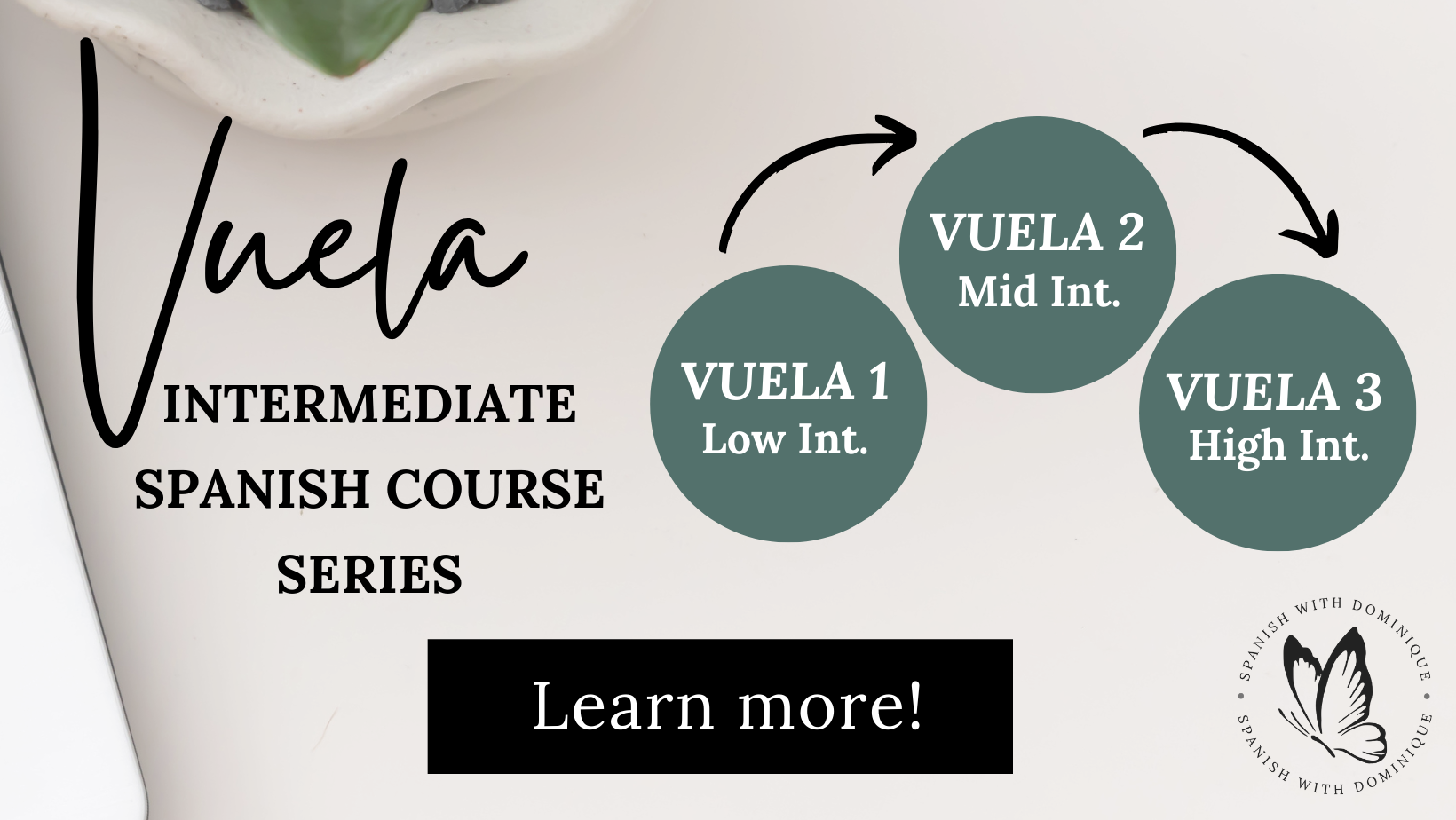How to Make the Most of Your First Spanish Immersion Trip
In this post: Five tips to help make your first Spanish immersion trip wildly successful.
Are you dreaming of packing your bags and going on one of those Spanish immersion trips for adults? Maybe spending a few weeks in Oaxaca or Antigua… Sounds exciting!
But will you actually improve your Spanish with immersion travel? The answer depends on you and how you prepare.
Many people think that traveling to a Spanish-speaking country will automatically help them reach their Spanish goals.But that’s not entirely true.
In fact, the most important component of those Spanish immersion trips is the immersive experience — because it’s more effective than traditional forms of classrom learning.
But you can absolutely create an immersive Spanish learning experience for yourself without ever leaving home. Just like it’s possible to spend weeks (and lots of money) in a Spanish-speaking country without really immersing yourself!
Today, you’ll learn how to have a great Spanish immersion experience — where you get to enjoy all the authentic local flavors, have a meaningful trip, and actually make progress with your Spanish. (And I’ll help you avoid some of the mistakes that can undermine your progress and enjoyment in your immersion experience too).
While reading this post, consider these questions:
What are some ways you can think of to immerse yourself in Spanish now — before you leave?
Do you feel comfortable speaking with native speakers and joining conversations? Or could you use a little more practice first?
Do you have an immersion plan already? (If not, read on).
Tip #1: Go with an immersion plan
Planning for a few details can make a big difference in the results you see from your Spanish language immersion.
Think about other kinds of major transformation — like losing 15 pounds. You can’t do it without some smaller steps like meal planning, a workout plan, and a schedule... Do you see where I’m going with this?
To get the most out of your Spanish immersion travel experience, you’ll want to create a plan with some great micro-steps (those little things you’ll do again and again that will ensure your success).
Here are a few ideas of what should go into your plan:
Create a daily schedule of how you will spend your time.
Have downtime fun materials with you — a Spanish language book to read, a magazine to look over, or a playlist ready.
Make time for socializing with locals (even in small doses at first).
Plan different kinds of purposeful study activities with high-quality study materials (that you’ll bring with you!).
Questions to ask yourself while you're planning your Spanish immersion trip:
You are about to travel long distances and invest a lot of time and money in fundamentally changing the way you communicate in Spanish. That kind of transformation is incredible — but it takes an organized plan. You’ll want to start with the big questions first.
“How long should I go for?”
As part of your planning phase, you’re smart to ask. You probably won’t see significant changes in your Spanish without staying for at least three weeks. If you have more time on your hands, two months in an intensive immersion program is about as much as you can reasonably focus on in a short period of time.
“How many hours a day should I take classes?”
Your mental bandwidth for language learning has its limits. I recommend taking 4 hours of formal classes per day and then spending the rest of your time immersing yourself in the language naturally — take a cooking class, go on a local tour in Spanish, interact with locals at restaurants and the grocery store.
“Where should I go for my first Spanish immersion trip?”
My top Spanish immersion city recommendations in Latin America are Oaxaca City, Mexico, and Antigua, Guatemala. These are charming colonial towns with an easier pace of life which will give you the mental space to focus on your studies.
Although, if you want the feel the big hustle and bustle of city life, Mexico City is a great option.
“What Spanish immersion school am I going to attend?”
A simple Google Search will give you the top three language schools in the area. Make sure to read reviews by other students and check out the location and schedule. The top language schools will have a similar curriculum, so it really just comes down to price, location, and schedule.
Once you choose your school, find an Airbnb close by or ask if the school offers homestays (this is where you can live with a host family during your stay, which is the ultimate form of immersion!)
Tip #2: Spend time with Spanish speakers
We all know them: people who have spent lengthy amounts of time in a Spanish-speaking country and still come back no more fluent in the language than when they left. What they do often feel is a sense of having missed an incredible opportunity. How is that possible?
Here’s a hint: they spent all their time with other English speakers. It’s really easy to do if you don’t plan ahead. In fact, it’s kind of the default with intensive immersion trips in Latin America, where the vast amount of people who join are native English speakers.
Instead, do what my longtime student Dani did. After two years of studying Spanish online, Dani took her first solo Spanish immersion trip to Cabo San Lucas, Mexico, all the way from Canada. She focused on immersing herself in the local culture as much as possible. Here’s what she said about that (memorable and rewarding) trip:
“Instead of going to touristy spots (where everyone speaks English), I stayed close to the local neighborhoods, attended a local yoga class, and went out for dinners with fellow students and teachers. I did grocery shopping at local markets rather than the big-name/common places. When I was in line at stores or sitting at parks/the ocean, I tried to listen to families talk next to me. I was really conscious about trying to understand any conversations around me instead of being consumed on my phone like I usually am in the city.”
I know what you’re probably thinking. Dani is brave and outgoing. She stepped out of her comfort zone and did some incredible things. That might feel scary to you — especially if you’re more reserved or introverted. But you can absolutely achieve those kinds of results by referring back to Tip #1 (your secret weapon) — going with a plan!
Tip #3: Pretend you’re in college again
The people I have known who have grown the most through Spanish immersion trips are the ones who follow this advice — and really commit to being students of Spanish again.
As an adult, readjusting to the student mindset can feel strange at first. After all, you’ve got a career and a family.
But does it really surprise you to know they were committed to their goal and also their ways of reaching that goal? I bet it doesn’t. The kind of people who read this blog are used to taking responsibility for their learning and their lives.
Here are some things you can do to make sure you get the most from your Spanish immersion:
Show up early to class.
Take notes.
Ask questions.
Sit in the front of the class.
Take ownership of your learning.
Tip #4: Step outside your comfort zone
Stepping out of your comfort zone is, well, a little scary by definition. In fact, there’s probably at least a small part of you who is thrilled about the new experiences you’ll have when you travel to a Spanish-speaking country.
But, on the other hand, it’s also pretty exciting.
It’s not always easy to do — I know. But when you step out of your comfort zone, that’s when you see a change in yourself and your Spanish.
I’ve been there myself and have known so many people who have gone abroad and really taken small risks and spread their wings.
Like my student Limell who spent six weeks in Ecuador on a Spanish Immersion trip. She sent me this via WhatsApp…
Tip #5: Go analog
I love technology; I really do. But it’s something I’ve learned to be mindful of in my life, my work, and my learning. And if you’re going on a Spanish immersion trip, you’ll want to be as analog as possible.
Technology leaves you thinking you’re making progress while also distracting you from having the kind of human interaction that can really change the way you see the world — and that can change your Spanish too.
You can do this simply by deleting Google Translate from your phone and carrying a dictionary around. Or, if you’re really feeling adventurous, don’t even pay the extra for the international plan, so you only have internet access when you have wifi.
You might be wondering how you’ll get around the city. You can download the Maps.me App, and then you have a map of the city accessible anywhere. Or you can get a physical map of the city at a local tourist office and be really old-school!
And if you’re worried about how you’ll call an Uber? Why don’t you choose to take the 15-minute walk or even learn to navigate public transportation? It will force you to interact with locals, ask questions and find your way around.
When I spent a year living in Barcelona in 2011, I purposely sold my iPhone and purchased a flip phone (yes! a flip phone!) because I wanted to be fully present in my experience. I took a 40 min train ride to my classes in Barcelona from my small village every day. Those hours on the train enriched my learning in amazing ways - I would listen to conversations around me or music on my iPod.
With just my notebook in hand, I would write notes or translate song lyrics using my pocket dictionary. I also started having short conversations with people sitting around me and made friends with people I would commute with into the city. Imagine if I had my head down on scrolling Instagram that whole time.
Your key takeaways for how to make the most out of your Spanish immersion trip.
Remember that your Spanish immersion trip will be as meaningful, memorable, and worthwhile as you make it.
Traveling to a Spanish-speaking country is not a magic pill for learning the language. But if you’re committed to having a life-changing, authentic experience, you can absolutely do it.
Be sure to go in with an immersion plan and an open mind.
Be ready to step out of your comfort zone, spend time with locals — and, most of all, have fun.
More Posts Handpicked Just For You!
Enjoyed this post? Here are some more you might like.







Discover 7 must-read books for intermediate Spanish learners to boost fluency, overcome the plateau, and immerse yourself in engaging Spanish stories.